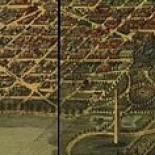Beginnings of Memorial Day — Decoration Day, 1869, Washington DC
The Grand Army of the Republic, in 1868, inaugurated the tradition which would lead to our modern Memorial Day holiday.
Headquarters Grand Army of the Republic,
Washington, D.C., May 5, 1868.GENERAL ORDERS
No. 11I. The 30th day of May, 1868 is designated for the purpose of strewing with flowers or otherwise decorating the graves of comrades who died in defense of their country during the late rebellion, and whose bodies now lie in almost every city, village, and hamlet churchyard in the land. In this observance no form or ceremony is prescribed, but posts and comrades will in their own way arrange such fitting services and testimonials of respect as circumstances may permit.
In 1869 (with more that three weeks notice) the commemoration really took off. The Evening Star of May 29, 1869 reported that afternoon on the earlier ceremonies of the day. The Star‘s editorial column noted that much federal and municipal business was suspended for the commemoration.
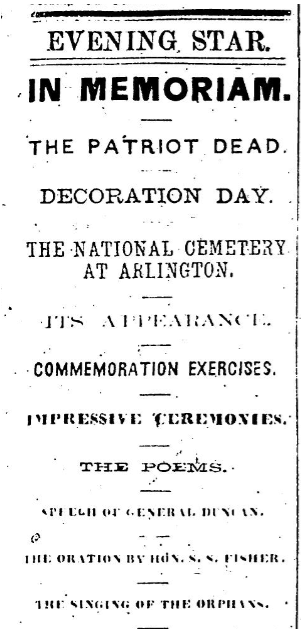
Over one half of the front page of the paper was devoted to the coverage–quite a vast amount, considering the entire paper was only four pages. Crowds at Arlington Cemetery were estimated to be over 25,000, quite a turnout considering the District’s population of approximately 175,000. Getting to the ceremonies at Arlington National Cemetery was a challenge–not overcome until the construction of Arlington Memorial Bridge (see my column “The Bridge a Traffic Jam Built: Arlington Memorial Bridge”
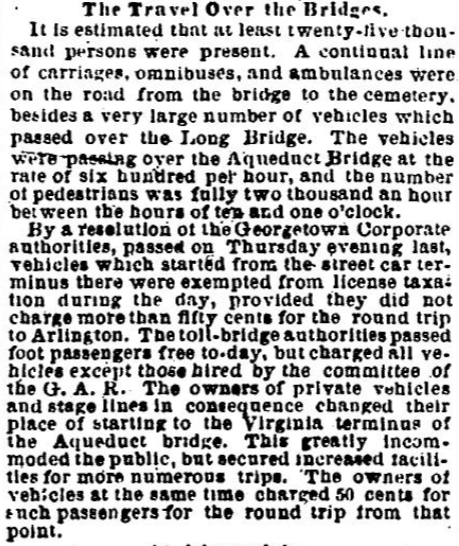
The ceremonies concentrated on Arlington Cemetery but now included other local cemeteries and war-related monuments (very few in Washington in 1869.) The new Lincoln Monument, located in front of City Hall in the center of D Street, was well-decorated. The monument was the local expression of loss of President Lincoln (see Washington’s Lincoln: The First Monument to the Martyred President” The Lincoln National Monument (as it was called) had been unveiled April 14, 1868, three years to the day of the assassination–just a month before the first Decoration Day.
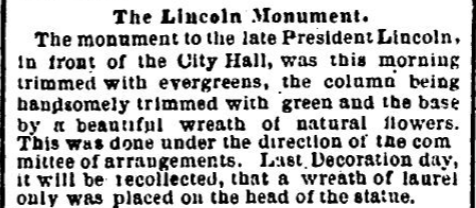
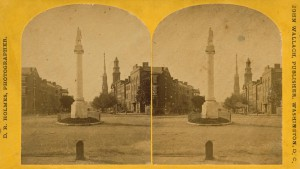
The main event at Arlington Cemetery was open by Timothy Lubey GAR Potomac Department chairman of arrangements. Irishman Captain Timothy Lubey had served in Company C of the 15th New York Engineers.1 General Samuel A. Duncan, Grand Commander of the Potomac Department spoke; Lubey followed reading the GAR order setting aside the day for commemoration. The program continued with songs, poems, speeches, and sermons.
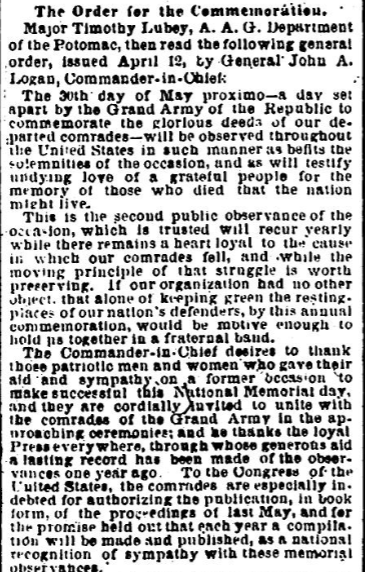
Samuel S. Fisher, Commissioner of Patents, gave the main address, laying out lessons learn from the war and a issued a call for reconciliation.
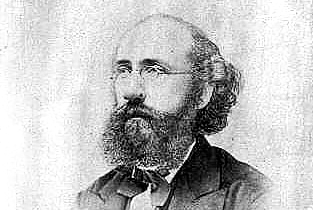
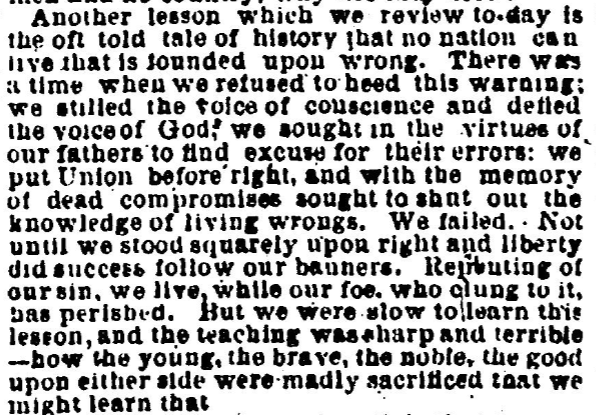
Flowers were placed on all the graves (white-washed wooden headboards in those days) in Arlington Cemetery. Similar ceremonies took place in Alexandria following the conclusion of those at Arlington. More continued into the next day–at Soldiers’ Home and the nearby cemeteries, as noted in the Monday Star. Battleground, Oak Hill, Glenwood, Mount Olivet were all decorated, as was Congressional.
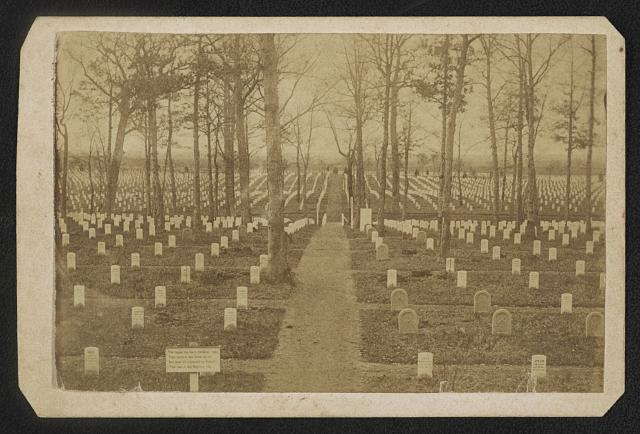
Date Created/Published: [Arlington, Virginia] : [Publisher not identified], [ca. 1865] — Library of Congress
For some context: At the end of April 1868, uniform rows of white-washed wooden headboards, each representing a gravesite of a fallen Civil War service member, filled the hills of Arlington National Cemetery (ANC). The property’s prominent ridgeline, marked by the Arlington House, offered stunning views of Washington, D.C. Little else distinguished this national cemetery as remarkable. While it contained the graves of some 16,000 individuals and spanned 200 acres, Arlington was only one of approximately 74 national cemeteries established beginning in 1862, during the Civil War.2
PS Washington DC’s Grand Army of the Republic memorial3
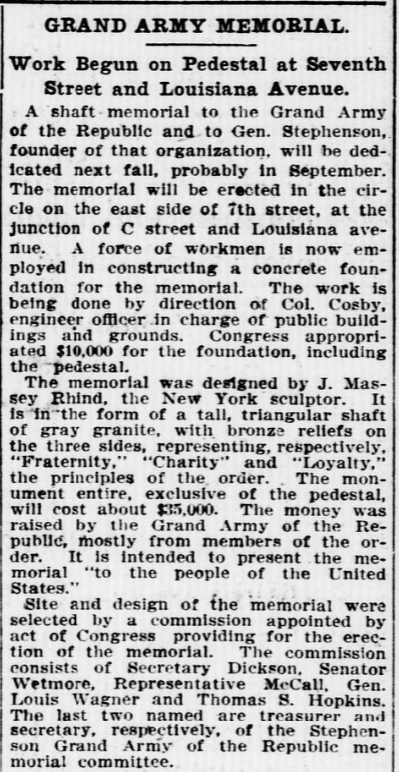
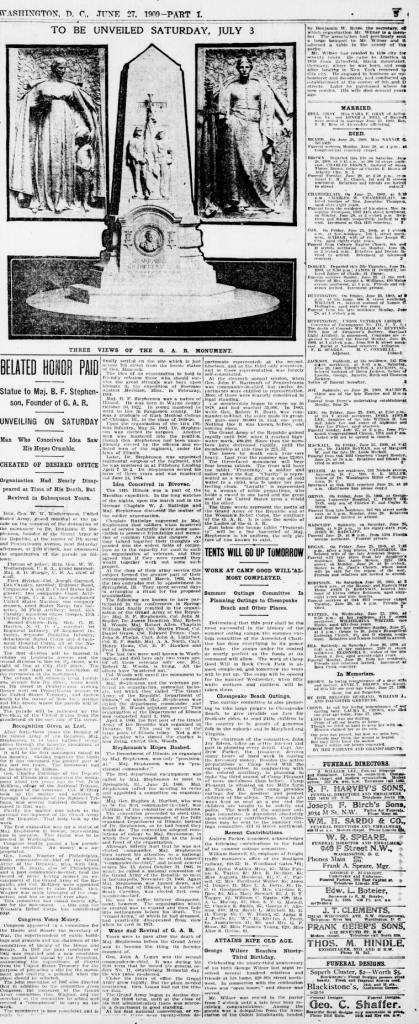

Notes
1Lubey died December 12, 1877.
3Washington’s GAR memorial https://web.archive.org/web/20151122040227/http://siris-artinventories.si.edu/ipac20/ipac.jsp?&profile=all&source=~!siartinventories&uri=full=3100001~!21662~!0
Resources
LOC Grand Army of the Republic resources https://guides.loc.gov/grand-army-of-the-republic/state-encampments/potomac NOTE: early materials were not formally printed and published (or preserved)
http://genealogytrails.com/vir/arlington/hist_arlingtoncemetery_memorialceremonies.html Arlington National Cemetery Memorial Ceremonies, May 30, 1868 Source: “Memorial Ceremonies at the National Cemetery, Arlington, Virginia; Under the Auspices By The Grand Army of the Republic”; publ. 1868; re-transcribed by G.T. Transcription Team
https://www.arlingtoncemetery.mil/Explore/History-of-Arlington-National-Cemetery
The History of Memorial Day
Share this:
Decoration Day, 1869, Washington DC
The Grand Army of the Republic, in 1868, inaugurated the tradition which would lead to our modern Memorial Day holiday.
Headquarters Grand Army of the Republic,
Washington, D.C., May 5, 1868.GENERAL ORDERS
No. 11I. The 30th day of May, 1868 is designated for the purpose of strewing with flowers or otherwise decorating the graves of comrades who died in defense of their country during the late rebellion, and whose bodies now lie in almost every city, village, and hamlet churchyard in the land. In this observance no form or ceremony is prescribed, but posts and comrades will in their own way arrange such fitting services and testimonials of respect as circumstances may permit.
In 1869 (with more notice) the commemoration really took off. The Evening Star of May 29, 1869 reported that afternoon on the earlier ceremonies of the day. The Star‘s editorial column noted that much federal and municipal business was suspended for the commemoration.

Over one half of the front page of the paper was devoted to the coverage–quite a vast amount, considering the entire paper was only four pages. Crowds at Arlington Cemetery were estimated to be over 25,000, quite a turnout considering the District’s population of approximately 175,000. Getting to the ceremonies at Arlington National Cemetery was a challenge–not overcome until the construction of Arlington Memorial Bridge (see my column “The Bridge a Traffic Jam Built: Arlington Memorial Bridge”

The ceremonies concentrated on Arlington Cemetery but now included other local cemeteries and war-related monuments (very few in Washington in 1869.) The new Lincoln Monument, located in front of City Hall in the center of D Street, was well-decorated. The monument was the local expression of loss of President Lincoln (see Washington’s Lincoln: The First Monument to the Martyred President” The Lincoln National Monument (as it was called) had been unveiled April 14, 1868, three years to the day of the assassination–just a month before the first Decoration Day.


The main event at Arlington Cemetery was open by Timothy Lubey GAR Potomac Department chairman of arrangements. Irishman Captain Timothy Lubey had served in Company C of the 15th New York Engineers.1 General Samuel A. Duncan, Grand Commander of the Potomac Department spoke; Lubey followed reading the GAR order setting aside the day for commemoration. The program continued with songs, poems, speeches, and sermons.

Samuel S. Fisher, Commissioner of Patents, gave the main address, laying out lessons learn from the war and a issued a call for reconciliation.


Flowers were placed on all the graves (white-washed wooden headboards in those days) in Arlington Cemetery. Similar ceremonies took place in Alexandria following the conclusion of those at Arlington. More continued into the next day–at Soldiers’ Home and the nearby cemeteries, as noted in the Monday Star. Battleground, Oak Hill, Glenwood, Mount Olivet were all decorated, as was Congressional.

Date Created/Published: [Arlington, Virginia] : [Publisher not identified], [ca. 1865] — Library of Congress
For some context: At the end of April 1868, uniform rows of white-washed wooden headboards, each representing a gravesite of a fallen Civil War service member, filled the hills of Arlington National Cemetery (ANC). The property’s prominent ridgeline, marked by the Arlington House, offered stunning views of Washington, D.C. Little else distinguished this national cemetery as remarkable. While it contained the graves of some 16,000 individuals and spanned 200 acres, Arlington was only one of approximately 74 national cemeteries established beginning in 1862, during the Civil War.2
PS Washington DC’s Grand Army of the Republic memorial3



Notes
1Lubey died December 12, 1877.
3Washington’s GAR memorial https://web.archive.org/web/20151122040227/http://siris-artinventories.si.edu/ipac20/ipac.jsp?&profile=all&source=~!siartinventories&uri=full=3100001~!21662~!0
Resources
LOC Grand Army of the Republic resources https://guides.loc.gov/grand-army-of-the-republic/state-encampments/potomac NOTE: early materials were not formally printed and published (or preserved)
http://genealogytrails.com/vir/arlington/hist_arlingtoncemetery_memorialceremonies.html Arlington National Cemetery Memorial Ceremonies, May 30, 1868 Source: “Memorial Ceremonies at the National Cemetery, Arlington, Virginia; Under the Auspices By The Grand Army of the Republic”; publ. 1868; re-transcribed by G.T. Transcription Team
https://www.arlingtoncemetery.mil/Explore/History-of-Arlington-National-Cemetery
The History of Memorial Day
